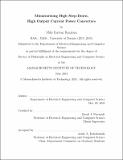Miniaturizing High Step-Down, High Output Current Power Converters
Author(s)
Ranjram, Mike Kavian
DownloadThesis PDF (54.90Mb)
Advisor
Perreault, David J.
Terms of use
Metadata
Show full item recordAbstract
Power conversion systems providing high voltage step-down capability at high output current are required in many applications, such as data center servers, electric vehicle charging, and USB power delivery. Converter miniaturization is a critical but especially challenging design goal, and transformers present a key bottleneck in this effort. To address this challenge, a new paradigm for magnetic component design is proposed in which magnetic and electronic elements are viewed as a single ``coupled electronic and magnetic system'' (CEMS).
The first proposed CEMS is the Variable Inverter/Rectifier Transformer (VIRT), which enables a transformer with fractional and reconfigurable effective turns ratios (e.g. 12:0.5, 12:2/3, 12:1, and 12:2). Its wide gain variation and high step-down capability are utilized in a 120-380V input, 5-20V, 5A/36W output dc/dc converter having a peak efficiency of 96% and greater than 93% efficiency across the wide range. The VIRT is also employed in a two-stage universal ac input, 5/9/12V, 5A/50W output portable charger having a component power density of 55W/in3 and a peak end-to-end efficiency of 95.7%.
Challenges associated with leveraging highly interleaved high-layer-count planar windings - another means for handling high current - are elucidated and mitigation strategies are proposed. A novel winding termination strategy is demonstrated to reduce ac resistance by more than 40% in a highly interleaved design.
A CEMS that is especially well suited for processing high output current is derived by combining the VIRT with popular multi-phase concepts. The resulting split-phase half-turn VIRT is employed in a 380V input, 12V/1kW output data center supply having a peak efficiency of 97.7% and a full-load efficiency of 97.1% with a transformer volume up to 36% smaller than best-in-class alternatives. Finally, a generalized modeling framework for developing new CEMS implementations is presented.
Date issued
2021-06Department
Massachusetts Institute of Technology. Department of Electrical Engineering and Computer SciencePublisher
Massachusetts Institute of Technology